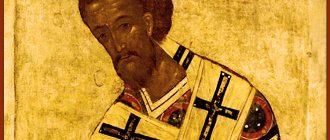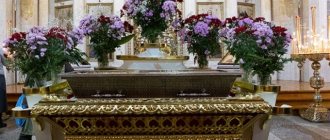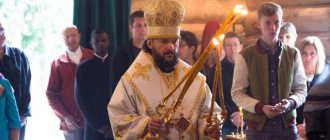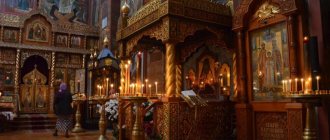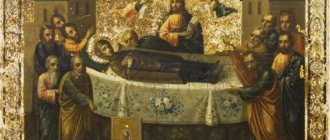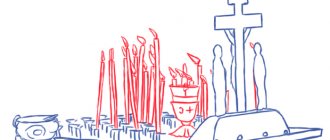| Ep. John (Pommer) |
John (Pommer)
(1876 - 1934), Archbishop of Riga and Mitau, Hieromartyr Commemorated on September 29 on the day of his death, in the Cathedral of New Martyrs and Confessors of Russia, in the Cathedrals of Belarusian and Galician Saints
In the world, Ivan Andreevich Pommer, was born on January 6, 1876 in the Ilzessala farmstead of Prauliensky volost in the family of a pious Orthodox Latvian peasant. His parents were simple, devout and pious Christians, and his great-grandfather was one of the first Latvians to convert to the Orthodox faith. Constantly helping his parents in hard peasant labor, the youth John grew up strong and physically resilient. At the same time, he was distinguished by his thoughtfulness, thirst for knowledge of the Word of God, and had a dreamy nature. He studied diligently and behaved exemplarily. In August 1887, he enrolled in the Riga Theological School, after graduating from which, in 1891 he entered the Riga Theological Seminary. Even then, John was distinguished by his firmness in faith. In June 1897, he graduated from the full course of the seminary with a 1st degree diploma.
In 1897-1899 he was a teacher at the Laudon parish school, and from 1899 to 1900 - in Libau (now Liepaja).
Then, from 1900 to 1904, he studied at the Kyiv Theological Academy, from which he graduated with honors and a candidate of theology degree. Here, in 1903, he accepted monasticism on the advice of Righteous John of Kronstadt, on September 23, 1903, he was ordained to the rank of hierodeacon, and on July 13, 1904, to the rank of hieromonk. While studying at the academy, he led the singing of the academic choir.
Teacher
Since 1904 - teacher of the Holy Scriptures at the Chernigov Theological Seminary. He quickly became known as a talented teacher.
Since 1906 - inspector of the Vologda Theological Seminary. Having shown a strong character, he participated in the successful restoration of order in this seminary during the period of revolutionary unrest, which contributed to his rapid promotion.
On September 26, 1907, he was elevated to the rank of archimandrite by the Archbishop of Vologda, and was soon appointed rector of the Lithuanian Theological Seminary and rector of the Vilna Holy Trinity Monastery. Thanks to the tireless care and dedicated work of Archimandrite John, the seminary was transformed beyond recognition.
Suffragan Bishop
On March 11, 1912, he was consecrated Bishop of Slutsk, vicar of the Minsk diocese. The consecration in the Alexander Nevsky Lavra was led by Metropolitan Vladimir (Epiphany) of Moscow and Metropolitan Flavian (Gorodetsky) of Kiev.
In 1912 he served as bishop in Odessa.
On April 4, 1913, he was appointed to the newly opened vicar see of the Ekaterinoslav diocese, with the title of Bishop of Taganrog and Azov. Already at this pulpit, the bishop was subjected to false accusations and imprisonment. When the bishop was imprisoned, a mass of people approached the prison in procession and demanded the release of their saint. Unable to resist the people, the persecutors released Bishop John from prison and, accompanied by his faithful flock, singing prayers, the archpastor went to the cathedral to serve a thanksgiving prayer service.
On September 7 (20), 1917, he was appointed Bishop of Staritsky, vicar of the Tver diocese.
Penza bishop
On April 22, 1918 - Bishop of Penza and Saransk, and was later elevated to the rank of archbishop.
Here he had to fight the “people's Church” organized in Penza by defrocked Archbishop Vladimir (Putyata) - one of the first non-canonical church groups of the renovationist type, which, with the support of the Bolsheviks, was destroying diocesan life. Heretical schismatics captured the Penza Cathedral and the main churches.
Archbishop John arrived at his new place of ministry in Penza on Tuesday of Holy Week 1918. The believers greeted him with love and surrounded him with signs of the most touching attention, settling him in a country monastery to avoid a sudden attack. The Living Church members were going to seize the Peter and Paul Church of the city on Maundy Thursday, but Bishop John, with an inspired sermon, converted those who were hesitant to follow Christ and the true Church. Already the first services attracted the hearts of many believers to him.
From the very beginning, the Bolshevik government treated the new archpastor with extreme hostility. They carried out a thorough search of the bishop's house, conducted an interrogation, but did not even find a reason for persecution. The schismatic false bishop and the security officers supporting him, seeing their complete defeat, decided to kill Archbishop John. On the evening of Thursday of Bright Week, two security officers entered the monastery, broke the doors and one of the attackers shot point-blank at the archbishop standing in the middle of the cell. But the monk, hiding on the side of the door, hit the shooter in the hand and the bullet hit the bishop in the leg, causing only a small wound, while the other monks sounded the alarm. The workers who had come running to the alarm gathered in the cell and wanted to commit lynching on the spot against those who had attempted to do so, and only the decisive intervention of the bishop saved their lives.
The Bolsheviks did not abandon their intentions to deal with the archpastor. In May 1918, they opened artillery fire on the Transfiguration Monastery, where the archbishop was staying, and several shells hit the cells adjacent to the cell of Bishop John, without causing him any harm. In September 1918, a thorough search was carried out in the cell and office of Archbishop John, which did not yield any results, and the bishop himself was taken to the Gubchek for a confrontation. Memorial services for the “newly deceased” Archbishop John had already begun to be held in churches, but this time the Bolsheviks released him.
On the feast of the Beheading of John the Baptist, schismatics attempted to seize the Peter and Paul Church, but the Bishop inspired the people to defend the temple. Then Archbishop John was arrested by the Cheka, he was imprisoned and prepared for execution. But the people of God demanded the release of the archpastor and at the last deadline, at about one in the morning on the day of the scheduled execution, it was announced to him that he was free.
During the imprisonment of the holy confessor, the godless authorities abolished all bodies of diocesan administration, but soon the bishop managed to achieve the restoration of the diocesan council and other bodies.
On July 28, 1919, Archbishop John was summoned to the military commissariat, where he was subjected to a recruiting examination and declared fit for military service, enlisting in the rear militia. At the request of the parishes of the diocese, the appearance in the militia was temporarily postponed. Visiting the parishes of the diocese was impossible without special permission from the persecutors. The White Army was approaching Penza and the persecution of the Church intensified, the most prominent church ministers were arrested.
At this time, at the invitation of the parishes, the archbishop went on a long trip around the diocese. The people joyfully greeted their archpastor. The services were held with great spiritual enthusiasm and in the presence of huge masses of people. Upon returning to Penza, in October 1919, the ruler was arrested again, slandered for his participation in a counter-revolutionary organization invented by the security officers.
At that time, those arrested were subjected to severe torture; some could not stand the torture and slandered not only themselves, but also other innocents. Thus the bishop’s subdeacon was slandered and shot. The same fate was prepared for the saint. But the bishop demanded a review of the case in Moscow. Transferred to a Moscow prison, he was placed in the same cell with criminals. One of the witnesses to his imprisonment said that one night a frostbitten and intoxicated criminal was brought to a prison cell. Seeing the archbishop, he began to mock cynically, but was stopped by his comrades, who told him that it was the Archbishop of Penza. The Bishop, full of Christian mercy towards the new inhabitant of the cell, warmed him, fed him and looked after him. The Christian attitude awakened good feelings in the fallen man, and he became the saint’s helper. Together they carried typhoid patients on stretchers, cared for those lying unconscious, performing a feat of Christian charity at the risk of their own lives.
In Moscow, the chairman of the secret operational department of the Cheka himself took up the archbishop’s case. The persecutors collected all the slander that had ever been leveled against the bishop, but were unable to prove his guilt, and in March 1920, Archbishop John was acquitted.
Archbishop of Riga
Thus, Bishop John healed the schism in the Penza diocese, and the Patriarch appointed him Archbishop of Riga and Mitau. Penza clergy and laity did not want to let him go, but in view of the persistent requests of the Latvian flock, Saint Tikhon gave final consent to Archbishop John’s departure to Latvia, honoring him with a letter of gratitude for his selfless and fruitful work in various places of ministry in Russia.
In 1921, Bishop John took over the administration of the diocese and, at his request, the Latvian Church received broad autonomy while remaining part of the Russian Church: this decision was approved on June 21, 1921 by Patriarch Tikhon, the Synod and the Supreme Church Council.
Bishop John enjoyed great authority among Orthodox believers - both Latvians and Russians. In 1923, at the Council of the Orthodox Church in Latvia, its charter was adopted, providing all members of the church, without distinction of nationalities, with the rights provided for by the canons.
In 1926-1931, the bishop was a deputy of the Latvian Seimas, in which he actively defended the interests of the Orthodox Church and often came into conflict with representatives of left-wing parties. In 1926, he achieved the adoption of a law on the legal status of the Orthodox Church in Latvia, which stated that it had the right to “freely and openly implement” Orthodox doctrine. The Church and its institutions owned the rights of legal entities, the property rights of the Church were guaranteed, the creation of religious schools, the establishment of Orthodox societies and unions was allowed, and the decisions of the spiritual authorities in canonical matters were not subject to appeal in secular institutions. In pursuance of this law, on December 1, 1926, the Riga Theological Seminary was reopened. In addition, the bishop resolutely spoke out in defense of the interests of the Russian population of Latvia. With his participation, laws were adopted regulating the opening of Russian educational institutions, the main Russian schools and gymnasiums began to receive benefits from the cultural fund. The number of Russian educational institutions increased, public libraries were opened, and the situation in preschool education was improved.
Martyrdom
| Archbishop John (Pommer) |
The archbishop's health was undermined by backbreaking labor and difficult living conditions.
Suffering from physical ailments, he was forced to move to the bishop's dacha near Kishozero. Here Archbishop John was killed on the night of October 12, 1934. The Archbishop was tied to a door taken off its hinges and subjected to terrible torture on a workbench. Everything indicated that the saint’s legs were burned with fire, he was shot from a revolver and was set on fire alive. There were three main versions of the reasons for the death of the ruler. According to the first, adopted in Soviet times, he was killed by supporters of the Latvian leader Karlis Ulmanis because he advocated maintaining canonical ties with the Moscow Patriarchate, since after the death of Bishop John the Latvian Church came under the omophorion of the Patriarchate of Constantinople. However, there is no objective evidence for this version - in Latvian politics, Bishop John was more of an ally of the government in the fight against leftist forces.
The second version is related to conflicts within the Latvian Church, including disagreements between Bishop John and the public organization Russian Student Christian Movement. During the investigation into the murder of the archbishop, some members of this organization were arrested, and the activities of the movement itself in Latvia were prohibited. However, this version was not confirmed either.
The most common version connects the murder of Archbishop John with the activities of Soviet agents. Attention is drawn to the secret connections of the head of the Latvian Church with Orthodox believers in the USSR, from whom he received information about the persecution of religion - this could cause discontent among representatives of the Soviet government. In addition, as a politician in Latvia and a member of the Seimas, Archbishop John was a consistent anti-communist and critic of pro-Soviet forces in his country. There is an assumption that on the evening of October 11, the bishop was visited by the famous singer Leonid Sobinov, who had arrived in Riga, and the killers could have broken into the house when the archbishop opened the door for him. Sobinov himself soon died suddenly in a hotel room in Riga, and the Soviet embassy forbade performing an autopsy on the deceased, and the cause of death was declared to be a broken heart. The body of the deceased was quickly transported from the hotel to the embassy building, and then sent to Moscow by funeral train. However, this version is also based on assumptions and indirect evidence.
Reverence
In 2001, he was glorified as a locally revered saint by the Council of the Latvian Orthodox Church. The celebrations were marked by a religious procession through the entire city; The solemn service was attended by the President of Latvia Vaira Vike-Freiberga, representatives of the Seimas, local government, Catholic and Lutheran churches.
In the same year, by decision of the Holy Synod of the Russian Orthodox Church, the name of Bishop John was included in the Council of New Martyrs and Confessors of Russia of the 20th century.
In 2003, the found incorrupt relics of the Hieromartyr John took place from the Church of the Intercession of the Most Holy Theotokos at the Intercession Cemetery in Riga to the Cathedral of the Nativity of Christ.
“Ilyich is very unlike Christ”
Photo: vk.com
Since 1917, Saint John served in the Tver diocese, where before him renovationists tried to seize churches. Saint John speaks of them like this: “They inserted Marx into the binding of the Gospel and think that the people will accept him instead of the Gospel. They dressed the commissars in sacred vestments and think that the Orthodox will accept them as their shepherds and follow them. They replaced the image of Christ in the icon cases with a portrait of Lenin and are waiting for the people to “attach”.
Ilyich is very different from Christ. Christianity cannot be replaced by Marxism, no matter what robes you dress the preachers of Marxism in. Here is love incarnate, shedding its blood for guilty brothers, there is satanic malice, shedding the blood of innocent brothers like water.”
Essays
- “Memoirs of Archbishop John (Pommer)”:
- Almanac “Russian World and Latvia” No. 14: From the archives of St. Hieromartyr Archbishop of Riga and Latvia John (Pommer). Letters and other documents. Volume 1. Publication prepared by Sidyakov Yu.L., Riga 2008:
- Almanac “Russian World and Latvia” No. 20: From the archives of St. Hieromartyr Archbishop of Riga and Latvia John (Pommer). Letters and other documents. Volume 2. Publication prepared by Sidyakov Yu.L., Riga 2009:
- Almanac “Russian World and Latvia” No. 24: From the archives of St. Hieromartyr Archbishop of Riga and Latvia John (Pommer). Letters and other documents. Volume 3. Publication prepared by Sidyakov Yu.L., Riga 2011:
- Almanac “Russian World and Latvia” No. 37: From the archive of Hieromartyr John (Pommer). Letters and other documents. Volume IV (additional). Sidyakov Yu.L., Riga 2014:
Dacha near Kishozero
Photo from the site russkije.lv
Physical activity, experiences and difficult living conditions affected the health of the Latvian Archbishop. Vladyka moved to live in a dacha in Ozolkalne near Kishozero. Refused all security. The saint loved to spend his free time alone and in prayer. At the dacha he took care of the garden, worked on a workbench - he had carpentry skills since childhood.
Literature
- Almanac “Russian World and Latvia” No. 38: Archbishop John (Pommer): life and fate in the era / ed. Mazura S.A., Riga 2015:
- Almanac “Russian World and Latvia” No. 43: Mazur S.A. Orthodoxy of Latvia in documents of the era: Archbishop John (Pommer) in Latvia - 1921, Riga 2016.
- Biographical dictionary of graduates of the Kyiv Theological Academy: 1819-1920s. Materials from the collection of prof. Archpriest F.I. Titov and the KDA archive in four volumes. Volume II. K-P. // Publishing department of the Ukrainian Orthodox Church, Kyiv 2015, p. 549-550:
Hieromartyr John (Pommer), Archbishop of Riga
Janis (John) Pommer was born His parents were simple devout and pious Christians. Holy Orthodoxy entered the life of the Pommer family even under their great-grandfather, despite strong resistance and cruel persecution from German landowners. Every day and every period of work in this family began with prayer. The whole family gathered together, the father read a chapter from the New Testament, the children sang and read prayers. And in general, this family loved to sing church hymns. The seasons were counted not by months, but by church holidays. Constantly helping his parents in peasant work, the youth John grew up strong and physically resilient. At the same time, he was distinguished by his thoughtfulness, thirst for knowledge of the Word of God, and had a dreamy nature. He studied diligently and behaved exemplarily.
By the Providence of God, the poor rural boy had to study for ten years in distant Riga. In August 1887, John Pommer enrolled in the Riga Theological School, after graduating from which, in 1891 he entered the Riga Theological Seminary. John spent all his free time in the library. His comrades respected him for his brilliant abilities and willingness to help, for his heroic strength. When it was his turn to read at the service, John read soulfully and prayerfully. In 1900, John Pommer entered the Kyiv Theological Academy. There is no doubt that the shrines of Kyiv had a beneficial influence on the pious young man. During his years of study at the academy, his determination to devote his entire life to serving the Church of Christ strengthened. The future ascetic of the Latvian land was blessed on the path of monastic life by the great prayer book and wonderworker of the Russian land, St. Righteous John of Kronstadt. In 1903, at the age of 27, John Pommer took monastic vows, on September 23, 1903 he was ordained to the rank of hierodeacon, and on July 13, 1904 - to the rank of hieromonk. In 1904 he graduated from the Theological Academy with honors and a candidate of theology degree. While studying at the Theological Academy, Hieromonk John leads the singing of the academic choir. Serving God in the priesthood was for him a constant feat of confession and following the chief shepherd Christ, who said about His shepherds: “...I chose you out of the world, for this reason the world hates you. Remember the word that I told you: the servant is not his master. If you cast me out, you will be cast out; If you keep My word, they will keep yours... You will be cut off from the congregation; but the hour will come, and everyone who kills you will decide to offer service to God... You will be in a world of sorrow; but be of good cheer, for I have overcome the world” (John 15:19-20, 16:2:33). On September 26, 1907, the Archbishop of Vologda, Hieromonk John, elevated him to the rank of archimandrite, where he held the position of inspector, and the following year he was appointed rector of the Lithuanian Theological Seminary and rector of the Vilna Holy Trinity Monastery. Being an excellent preacher, Archimandrite John makes a lot of effort to put the art of preaching at the highest level, personally listens to the sermons of his students, and gives valuable instructions and explanations. Pays great attention to the splendor of the temple and monastery. Archimandrite John performs religious processions in rural parishes with the miraculous icon of the Mother of God. A huge number of worshipers take part in religious processions. Devout services, prayerful and clear readings, beautiful sermons penetrate deeply into the souls of the Orthodox people. The power of faith, hope and love is kindled in the hearts of people. Archimandrite John was unusually simple in his communication with people, and his sympathy for the needs of the poor people is amazing: no one left him “thin and inconsolable.” Archimandrite John, following Christ, contained in his heart the needs of the oppressed and disadvantaged. He was especially loved by the Russian and Belarusian poor, who received work, protection and support through him. This reveals the true essence of the Christian shepherd, who makes no difference between slave and free, Greek, Jew or representative of any nation. On March 11, 1912, in the Alexander Nevsky Lavra, by a council of bishops led by Metropolitan Vladimir of Moscow and Metropolitan Flavian of Kyiv, Archimandrite John was consecrated bishop and appointed to the city of Slutsk as vicar of Archbishop Michael of Minsk. In 1912, Bishop John performed episcopal service in Odessa, and after the death of Archbishop Dimitri of Kherson in 1913, he was appointed to the newly opened Azov See in Taganrog (1913-1917). The time of difficult trials and tragic upheavals of the First World War and the hard times of 1917 has come. The merciful love of Bishop John extended not only to his flock, but also to those suffering outside the fence of the Orthodox Church. Compassionate, effective assistance to refugees from Galicia not only eased their suffering, but also attracted many of them to convert to the fold of the Orthodox Church. As a result of the revolutionary coup of 1917, the new leaders launched the most severe persecution of the Church. Since ancient times, the enemy of the human race has instituted special persecution against archpastors and shepherds, hoping, by defeating the shepherds, to scatter the sheep of the flock of Christ. On September 7 (20), 1917, His Holiness Patriarch Tikhon appointed Bishop John to serve in the Tver diocese, where peaceful church life was disrupted. Helped by God's help, the wise archpastor quickly establishes church life. Seeing in Bishop John a good and wise shepherd, the Patriarch elevated him to the rank of archbishop, appointed him archbishop of Penza and Saransk and sent him to heal schism and heresy. The diocese was in a difficult situation. The local clergy, like a herd without a shepherd, became confused, and some of the priests even drifted into schisms. Heretical schismatics captured the Penza Cathedral and the main churches. Archbishop John arrived at his new place of ministry in Penza on Tuesday during Holy Week 1918, and already the first hierarchal services attracted the hearts of the people of God to the ruler. The Lord kept the righteous man for further confession and leadership of the sheep of His flock. And difficult trials and the feat of confession only strengthened the spiritual strength of the ruler. In this we see the great providence of God for the Orthodox people of the Latvian land, who endured a lot of suffering and persecution for the Orthodox faith. The state of the Orthodox Church of Latvia at that time of troubles was sad. Not recognized by the state, it was given over for plunder. The flock was scattered, and Orthodoxy was persecuted. Orthodoxy was predicted to end soon. During the years of the First World War and the revolution in Latvia, Orthodox theological education was destroyed, and the Riga Theological Seminary was taken away. The Riga See was widowed: there was no archpastor. After Latvia gained independence, the question of the position of the Orthodox Church in Latvia became acute. Those in power did not agree with the position of the diocese of the Russian Orthodox Church. The state of churches in the country was sad. Plundered and devastated during the occupation and civil war, they were desolate. Iconostases were destroyed, icons were desecrated, crucifixes were thrown into the trash, and the Riga Cathedral was destroyed. The tin from the domes of churches was removed to repair institutions... Not a single Orthodox church escaped these troubles. One after another, the best Orthodox churches were captured. The Riga Convent was also under threat of closure. In the Riga Orthodox Cathedral of the Nativity of Christ, some wanted to build a pantheon-tomb of national heroes, others thought to demolish it from the face of the earth. The Latvian clergy and laity, like a flock that did not have a shepherd, experienced with deep sorrow the widowhood of the Riga See and the unsettled position of Orthodoxy in the state, but what can the church people do without their archpastor? Pious pastors and laity turned to His Holiness Patriarch Tikhon with a humble request to bless Archbishop John (Pommer), who gained love through firmness in faith and confessional feat, to care for the Latvian flock. Bishop John healed the schism in the Penza diocese, and the Patriarch appointed him Archbishop of Riga and blessed him to leave for Latvia, but the Penza clergy and laity did not want to let go of their deeply beloved bishop. And only in view of the persistent requests of the Latvian flock, His Holiness Patriarch Tikhon gave final consent to Archbishop John’s departure to Latvia, honoring him with a letter of gratitude for his selfless and fruitful work in various places of ministry in Russia. On June 8 (21), 1921, His Holiness Patriarch Tikhon grants the rights of broad autonomy to the Orthodox Church in Latvia and by his decree appoints Archbishop John (Pommer) of Penza as Archbishop of Riga and Latvia. By the will of God, the bishop returns to Latvia with rich spiritual and administrative experience acquired in previous departments. At all stages of his ministry, he was guided primarily by the idea of spiritual revival of church life, service to God and people. Years of serving the Holy Church and standing for the faith enriched the saint with wisdom and prudence. He grew spiritually into a perfect man, able to guide others on the path of salvation, and showed a rare example of self-denial and devotion to the will of God. Walking along the paths of archpastoral service in the greatest humility, Vladyka John relied on the Lord in everything, not attributing anything to himself personally, but in everything he conformed to the will of God. With humility, the saint received the Latvian flock under his omophorion. In Riga, the archbishop was met by his new flock at the station and proceeded with a religious procession to the destroyed cathedral. Surrounded by the love of his flock, the bishop undertook a tour of parishes, strengthening faith and encouraging everyone to be firm in the faith. He experienced oppression by the authorities, but this was nothing compared to what he experienced from the Bolsheviks in Russia. The establishment of the rights of the Latvian Orthodox Church in the state required a lot of effort and work. Only thanks to the tireless selfless labors of Archbishop John, it was possible to achieve registration of the Church as a full-fledged legal entity, and only the Lord, who knows the heart, knows how much suffering the Bishop had to endure while carrying out this most important work. To achieve this, Archbishop John had to nominate his candidacy for elections to the Seimas*. The people supported their archpastor and repeatedly elected him as a member of the Latvian Parliament. The Bishop had to endure many humiliations, insults and even beatings, as a deputy, for testifying to the truth, but only in this way was he able to defend the Church. This was the end of the destruction of Orthodoxy in Latvia. Bishop John sacredly revered the canons of the Holy Orthodox Church and considered it most important for the independent Latvian Orthodox Church to be spiritually in the bosom of the Mother Church of the Moscow Patriarchate. He rejected all attempts of the Patriarchate of Constantinople and the Karlovac schismatics to force the Latvian Church to break with the Mother Church, unity with which is the testament of the holy archpastor for us. The entire life and ascetic labors of Saint John as an archbishop and deputy were aimed at serving the Church, his homeland Latvia and the common people. He cared equally about Russians, Latvians, and people of other nationalities. For him there were no friends or strangers, everyone was brothers. Defender and patron of the disadvantaged and poorest sections of the population, the ruler himself lived more than modestly. The dark and damp room that became his home in the basement of the cathedral, with a barred window near the ceiling, through which all the sounds of the central boulevard penetrated, was in an extremely neglected state. The smoky walls were covered with stains of mold and dampness. Living in the basement, Archbishop John received distinguished foreign guests there. Estonian, Finnish and English bishops visited the basement of the cathedral. One of the foreign visitors with tears in his eyes exclaimed: “Believe me, in my fatherland not a single prisoner lives in such a hole as you, head of the Latvian Orthodox Church.” The furnishings in the bishop’s cell were very simple: several armchairs, chairs, cabinets with books, icons. Above the table is a large portrait of His Holiness Patriarch Tikhon. We do not know how many tears were shed here by the holy confessor before the holy icons. Vladyka lovingly called his basement “my cave” and only laughed off any expressions of sympathy for his situation. Numerous visitors remembered him as smiling, simple and accessible in communication. Vladyka loved children very much, and the children loved him. How often he would go to a bookstore with a whole bunch of guys and buy books for everyone, sometimes for several tens of lats. And the joyful crowd of children, often forgetting to thank them, scattered to their homes, and he looked after them with quiet joy. After Easter Matins, according to ancient custom, the archbishop broke his fast with the poor. Here he felt like he was part of his own family. He never distinguished people by social origin. It didn’t matter to him who was in front of him: minister, general, aristocrat, peasant or worker. He saw the image of God in everyone. Often the bishop was visited by criminals who had just been released from prison. The Bishop helped them, the repentants, to start a new life. Everyone felt the joy of communicating with the saint. Kind to the good and the repentant, the archbishop was strict with himself and opposed those who persisted in error and the enemies of the Church. While protecting the Church, he did not spare himself and therefore enjoyed the universal love of zealots of piety both in Latvia and far beyond its borders. However, his health was undermined by backbreaking labor and difficult living conditions. Suffering from physical ailments, he was forced to move to the bishop's dacha near Kishozero - the place of his martyrdom. Relying on the Lord, the bishop lived without security in a dacha located in a deserted place. He loved solitude. Here his soul rested from the bustle of the world. The bishop spent his free time in prayer, worked in the garden, and did carpentry work on a workbench, on which his tormentors later subjected him to terrible torture. The martyrdom of the saint was announced by a fire at the bishop's dacha on the night of Thursday to Friday, October 12, 1934. Nobody knows who tortured the ruler. But these torments were cruel. The archbishop was tied to a door taken off its hinges and subjected to terrible torture on a workbench. Everything indicated that the saint’s legs were burned with fire, he was shot from a revolver and was set on fire alive. At the funeral of Archbishop John, the cathedral could not accommodate everyone. Many people stood along the streets along which the remains of the holy martyr were to be carried. The memory of the saint was kept in the hearts of the Orthodox, and nothing, not even the fear of persecution, could erase it. For many decades, at the Intercession Cemetery in Riga, at the tomb of the holy martyr, there were fresh flowers, candles, and pilgrims. There are known facts of healing and God's help to people through the prayers of the holy representative of the land of Latvia. The chapel at the Intercession Cemetery in Riga, where the relics of the martyr archpastor rested hidden, became a place of pilgrimage for many Orthodox Christians who faithfully honor his memory.
Material used from the monthly newspaper “World of Orthodoxy” No. 11 (104) November 2006
Source: https://pstgu.ru/
